Top chefs are often interrogated on their favourite dishes to cook at home, actors on their favourite films, writers on their favourite books – Wine Lister has sought out the ultimate drinking inspiration for special occasions, interviewing a handful of top wine producers on their favourite wines.
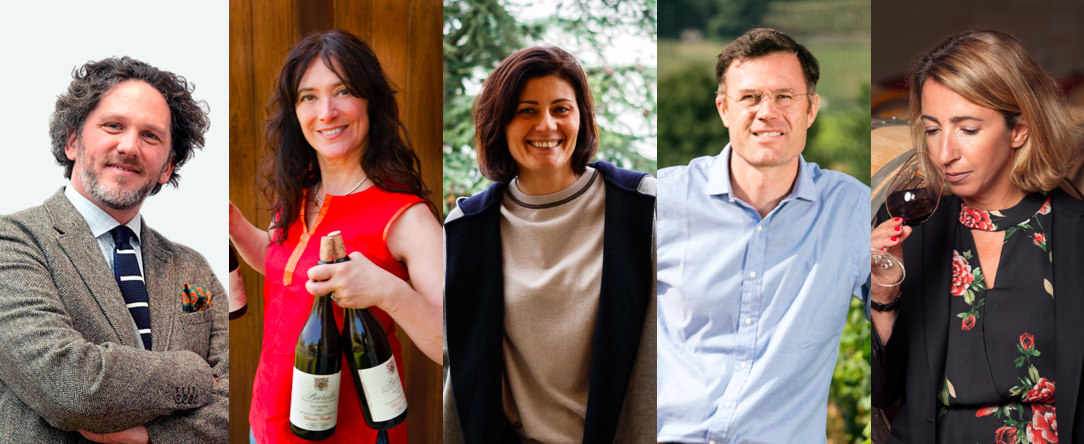 From left to right: Axel Heinz, Chiara Boschis, Gaia Gaja, Jacques Devauges, and Marielle Cazaux
From left to right: Axel Heinz, Chiara Boschis, Gaia Gaja, Jacques Devauges, and Marielle Cazaux
Axel Heinz – Ornellaia
“It’s certainly the most difficult question to answer for a winemaker”, Axel begins. Born in Germany, and spending his early career in Bordeaux before joining Ornellaia, his choice, once we twisted his arm, sits far from his professional vinous journey. “It would be a white, from my favourite Grand Cru in Burgundy: Corton Charlemagne”, he confesses, explaining that for him, these wines combine the structure and power of a red wine, with “the vibrancy, fragrance, and minerality that one can only find in great whites”. Admiring its capacity for a faithful expression of terroir, and display of true personal signature, he cites Coche-Dury as his go-to producer.
Chiara Boschis – E.Pira e Figli
With Barolo in her blood (her relatives founded the historic Giacomo Borgogno estate), it is not unusual that Chiara Boschis’ favourite wine should hail from this same noble Italian region. She tells us that she understood from a young age “the privilege to be born in such a generous land”, for which her parents, and the people around her had “great love and respect”. After years in the cellar at E.Pira, she too became “entirely captured by the magic of Barolo”. Chiara’s top choice is therefore a Barolo from the Mosconi vineyard for its “complexity and depth”, Cannubi for its “elegance”, and the vineyards of Via Nuova for their “diversity”.
Gaia Gaja – Gaja
While paying homage to her family’s past through her own wines, fifth generation winemaker, Gaia Gaja also has one eye on the future. Her favourite wine, from rising star appellation Mount Etna, Sicily, is Graci’s Etna Rosso Arcuria. The wine is made from one of the latest ripening European varieties, Nerello Mascalese, in one of the highest vineyards in Europe. She discovered it after “becoming close friends with Alberto Graci and his family”, often visiting them in Etna. Gaia explains that “the contrasts between its vibrancy, freshness, and warmth, as well as its perfume and smoky minerality”, remind her of “the snow and the fire of Etna”. Comparing it to Nebbiolo, she believes the grape has “intriguing personality, a strong identity of place, and a medium body that makes it versatile and easy to drink”.
Jacques Devauges – Clos des Lambrays
Moving from Clos de Tart to Clos des Lambrays last year, Jacques Devauges’ top wine of all-time was born close to home. He tells us that Comte Georges de Vogüé’s Musigny catalysed his passion for wine. Sampling the 1971 and 1978 as a teenager, he was “struck” by both, despite knowing very little about wine at that point. Jacques believes Vogüé’s Musigny shows “the signature of the Grand Vin”, to impress “not only the wine geek, or the collector, but everyone, even those who don’t know what makes a good wine”. Describing what “was almost a shock”, he notes that the “level of perfume on the nose was almost like a perfume you can put on your skin”, while the palate was “soft and delicate”.
Marielle Cazaux – La Conseillante
Joining La Conseillante from neighbouring Petit-Village in 2015, Marielle Cazaux tells us that if she had to pick a favourite wine, it would be Ridge Vineyards Monte Bello, because she “has so many special memories with this wine”. As an intern at Ridge in 2001, she had the chance to taste several vintages with the legendary Paul Draper, whom she calls “one of the most gifted winemakers of the US”. Marielle considers Monte Bello a “wine with extraordinary finesse”, and “a total sense of harmony”. Describing its notes of “black pepper, lavender, mocha, liquorice, and dried flowers”, she observes that it is “perhaps one of the most “Bordeaux” style wines in California”.
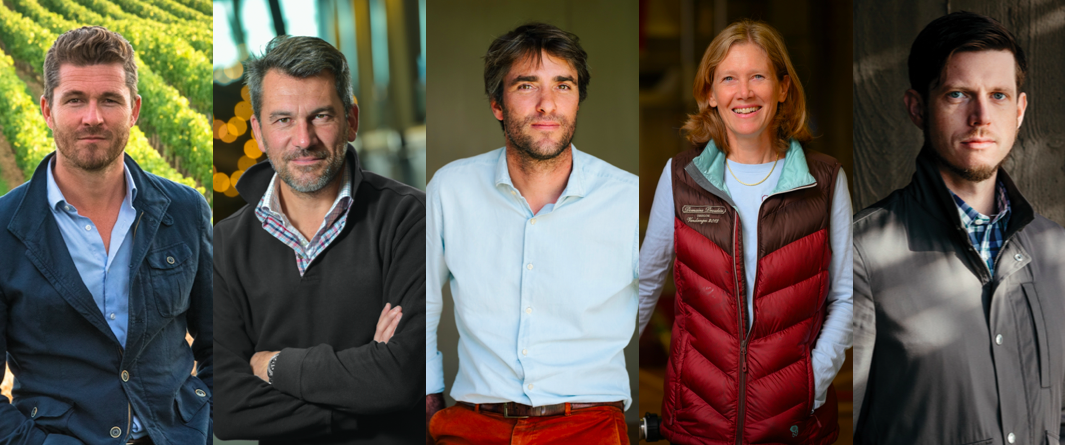 From left, Nicolas Audebert, Nicolas Glumineau, Pierre-Olivier Clouet, Veronique Boss Drouhin, and Will Harlan
From left, Nicolas Audebert, Nicolas Glumineau, Pierre-Olivier Clouet, Veronique Boss Drouhin, and Will Harlan
Nicolas Audebert – Rauzan-Ségla, Canon, and Berliquet
With some of the world’s most prestigious wineries under his belt (Terrazas de Los Andes, Cheval des Andes, Moët & Chandon, Krug, Veuve Clicquot), Nicolas echoes Axel Heinz in attempting to pick his favourite wine: “it’s impossible to answer. It’s like music – endless, initiatory, and progressive”. He instead recommends a wine from his friend, winemaker Andrea Felluga, with whom he “shares wine at simple, festive tables with lots of laughter”. He tells Wine Lister that Felluga’s wine, Livio Felluga Terre Alte “is a great white from Friuli” – a “land of contrast between the sunny and singing soul of Italy and the Alpine foothills, austere and cool”. Made from a blend of Friulano, Sauvignon Blanc, and Pinot Blanc, the Terre Alte is, according to Nicolas, like Felluga – “happy and lively”.
Nicolas Glumineau – Pichon Comtesse
On the subject of his favourite wine, Nicolas Glumineau (previously of Haut-Brion, Margaux, and Montrose), tells us that there are so many wines he could note – “Rayas 1990, E. Guigal La Mouline 1976, Cristal 1996, Trotanoy 2009, Diamond Creek Red Rock Terrace 2015”. White Burgundy legend, Coche-Dury, nonetheless gets another vote from Nicolas (on top of praise from Axel Heinz) as he reminisces trying the Meursault Caillerets 2006 for the first time in London, and being “choked, speechless, and moved by such perfection”. He describes the “delicacy of its white flower aromas and the elegance of its mineral and endless finish”, and recalls the feeling “that the world has stopped turning and that time has been suspended”.
Pierre-Olivier Clouet – Cheval Blanc
Echoing the sentiment of several of his peers, Pierre-Olivier Clouet (who has been at Cheval Blanc for 16 years), tells us that “it is impossible to choose just one wine”, because “like wine, the palate of the taster is constantly evolving”. Pierre-Olivier nonetheless notes his current favourite is “Mas Jullien – a wine that fully expresses the identity of the place where it is made, and injects the touch of balance and freshness that characterises all the great wines of the world”. He recalls that the last time he tasted the Languedoc red – a blend of Syrah, Carignan, and Mourvèdre – was with his team, on the last day of Cheval Blanc’s 2020 harvest.
Veronique Boss Drouhin – Joseph Drouhin
Fourth-generation winemaker, Veronique Boss Drouhin tells us that a wine she particularly enjoys was introduced to her by her close friend, Christine Vernay, daughter of the late Georges Vernay (praised for his key role in the survival of the Condrieu appellation). Veronique recalls Vernay opening a bottle of Georges Vernay Condrieu Coteau de Vernon, and being enchanted by its “aromatics, jumping out of the glass – unique, fragrant, and complex”, and a palate that was “powerful, voluptuous, and round, but with acidity to balance it” – a rarity for Viognier. She also cites Georges & Christophe Roumier’s Chambolle-Musigny Les Amoureuses as one of her favourites, adding, “Christophe’s [wine] is one of the nicest, purest, more elegant expressions of Pinot”.
Will Harlan – Promontory
Leading Harlan Estates‘ second-generation venture, Will Harlan explains to us that while he cannot choose a favourite, Jacques-Frederic Mugnier’s Musigny 2001 is a wine that he believes to “belong among the finest”. Will recalls coming across the bottle while “travelling with colleagues through Copenhagen a few years ago”, and as there hadn’t been a correct time to open it, the bottle joined them “on a course through Germany to Switzerland”. Having finally found an appropriate evening in Zurich to open it, “by the lake — the first bit of rest since the trip began”, he was “drawn in, as each feature of the wine, with a humble nobility, felt very naturally and confidently in its place”. Will notes it was a “wine that was singular and true”, that “would mark a memorable evening of our travels and in our friendships”.
The first of the Burgundy 2019 en primeur releases began this month, reigniting conversation of last year’s growing season, and its subsequent offerings. Wine Lister has spoken to several key Burgundy producers, and has sampled the 2019s from leading négociant, Louis Jadot, to get a better picture of this promising vintage.
Burgundy’s 2019 growing season was marked by a notably hot and dry summer, resulting in wines of extreme concentration. Due to a combination of spring frost, uneven flowering, and summer drought across many sites, yields in 2019 are significantly lower than average.
 A line-up from Louis Jadot’s 2019 en primeur tasting, organised by Hatch Mansfield at Vagabond, Monument on the 3rd of November 2020
A line-up from Louis Jadot’s 2019 en primeur tasting, organised by Hatch Mansfield at Vagabond, Monument on the 3rd of November 2020
Sourcing grapes from across the region, including its own holdings in some of Burgundy’s most prized plots (e.g. Chapelle Chambertin, Clos Vougeot, and Vosne-Romanée), Louis Jadot’s production in 2019 is down 50% for Chardonnay, and 30% for Pinot Noir. A cool and windy spring caused millerandage across Jadot’s sites, leading to many of the smaller, unripe berries being discarded. Warm temperatures in 2019 meant that grapes had high natural sugar levels, and correspondingly high alcohol across the region. Deputy General Manager, Thibault Gagey, tells us that several Louis Jadot wines are approaching 14 degrees in 2019, however, they nonetheless offer “good acidity, so they are powerful but balanced”, and there “isn’t a feeling of high alcohol”.
Wine Lister agrees whole-heartedly, and was particularly impressed by the quality of the whites. The Chablis Blanchot was “pure and lithe with an already-sumptuous texture”, while the Chassagne Montrachet Morgeot Clos de la Chapelle offered a delightful nose of “honey, truffle, and brioche”, with “rich citrus” on the palate. For reds, Wine Lister enjoyed the “complex and earth-toned” Clos Saint-Denis, and the “powerful but poised” Gevrey-Chambertin Clos Saint-Jacques. Gagey informs us that he is indeed “very proud of the 2019s”, and is “confident that it will be a good vintage”.
Across the Côte de Beaune, harvests were small in 2019. Arnaud Ente tells us that his namesake domaine saw “a spell of spring frost”, which caused significant damage and loss of yield, and “uneven weather patterns during flowering”, caused coulure and millerandage. The summer was mostly hot and dry, causing hydraulic stress to the vines, but “20-30mm of rainfall in late August” helped to unblock phenolic maturation, and allow the grapes to reach “impressive levels of maturity while maintaining good sugar levels, and also a very lovely acidity”. Ente notes that his 2019s have achieved “extraordinary balance, due to the acidity in the grapes developing slowly”. The vintage is of “enormous potential”, if down 20% on an average year in terms of volume.
Domaine Jean-Noël Gagnard similarly experienced significant frost in 2019; the principal cause of its small harvest. Winemaker Caroline Lestimé echoes the experience of “millerandage followed by hydraulic stress on the vines during the summer drought”, resulting in “small, but thankfully exceedingly concentrated berries”. Due to the two extremes of conditions throughout the season, Lestimé analysed the sugar / acid balance frequently near to harvest, so as to pick the optimum window for picking. Once again, quality here is likely a triumph, but Lestimé adds that “Jean-Noël Gagnard has not seen such a small harvest since 1999”.
Guillaume d’Angerville tells us that in Volnay, “frost risk was on everyone’s mind”, however, “dry and windy conditions helped to avoid frost damage” across Marquis d’Angerville’s plots. Water and heat stress in summer was a problem here too, “stopping the plant’s evolution, and veraison was delayed as a result”. He similarly explains that “selecting the correct harvest date proved difficult”, in part due to the “heterogenous grape maturation”, however in the end, “the entire range benefitted from the perfect maturity of the grapes”, despite yields being down 20-30% on the average year. He tells us that his 2019s are “succulent and full of energy”, without being “jammy” from such a hot year, and therefore providing “another successful vintage ending in 9”.
Akin to Louis Jadot, Winemaker Jean-Nicolas Méo tells us that Méo-Camuzet’s 2019s are “well-ripened”, with “fairly high alcohol levels, around 14 degrees”. He states that there is nonetheless “a nice acidity to start”, which provides the wines “a good freshness and a certain structure”, as well as lengthy ageing capacity. Echoing d’Angerville’s sentiment on the success of 9s, Méo foresees “an evolution of this vintage like the 2009: rich and greedy at first, then gradually closing, to emerge in a decade more tense and structured than suggested today”.
Despite the significantly reduced volumes in 2019, the quality of Burgundy’s latest vintage release clearly suggests a long and promising future ahead. The combination of these two factors will surely see demand outweigh supply for en primeur once again. For more guidance on buying Burgundy 2019 en primeur, and essential analysis to inform your wider Burgundy investment decisions, purchase our in-depth Burgundy study here.
Wine Lister’s recent in-depth Burgundy study considers the much-contended topic of the region’s rising prices, providing additional information for those planning on purchasing Burgundy 2019 en primeur over the coming months.
Below we examine the current distribution of prices of the 175 wines featured in the study, compared to the same wines two years ago. While 5% of wines were priced above £3,000 two years ago, a substantial 11% are today.
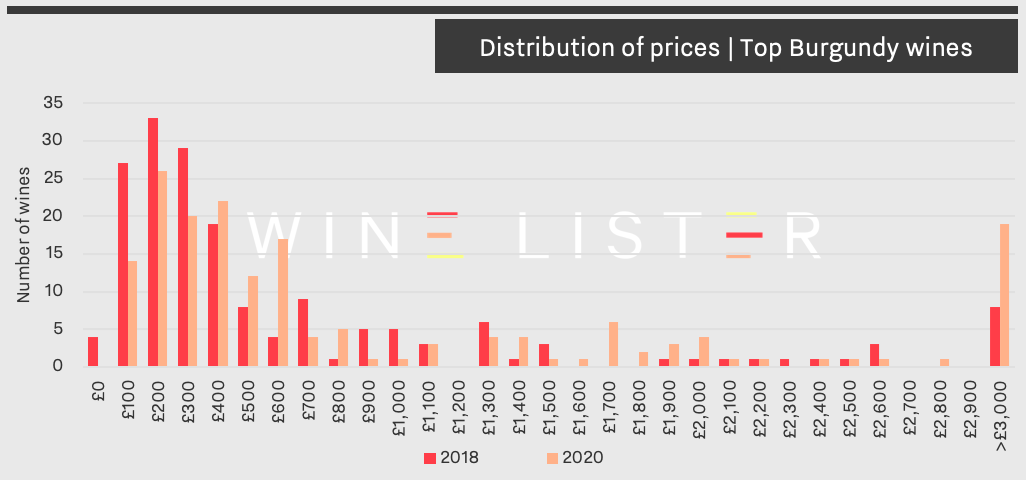
The graph above reveals a significant shift towards the higher end of the price scale, with multiple Burgundy wines previously priced between £1,900 and £2,700 now over £3,000. This comprises Comte Liger-Belair La Romanée, d’Auvenay’s Mazis-Chambertin and Bonnes-Mares, Domaine de la Romanée-Conti La Tâche, Jean-François Coche-Dury Corton-Charlemagne, and Leroy’s Richebourg, Romanée-Saint-Vivant, Clos de la Roche, Corton-Charlemagne, and Latricières-Chambertin.
Alongside the figures, feeling from Wine Lister’s recent Founding Member survey confirmed that Burgundy’s seemingly boundless prices are a concern, with over half of respondents voicing apprehensions on the topic. The most common sentiment is nonetheless that little will change for wines at the very top end, and that their prices will continue to climb, as demand continues to outweigh supply significantly. One specialist merchant in the Asian market informed us that they indeed foresee “Burgundy prices heading higher at the top end”, and that they “don’t see demand slowing despite the economic issues.”
The polarised prices illustrated in the graph are echoed by the trade, who cite a phenomenon of divergence between the top-end wines, and those at mid-range or entry-level. One respondent noted “an oversupply of generic and village Burgundy”, with another predicting that “when the smoke clears, all that remains will be Bourgogne Rouge/Blanc and the crown jewels, with no market in between”.
Despite the geopolitical context of the past two years, the buzz surrounding Burgundy remains strong, and competition will be hot for accessing the best wines of the 2019 vintage, particularly given its reduced production volume.
Visit the Analysis page to purchase Wine Lister’s in-depth 2020 Burgundy study, or download it using your Pro subscription here (available in both English and French).
Before the bulk of Burgundy en primeur 2019s are released onto the market, Wine Lister has published its second in-depth Burgundy study.
Below we explore the complex relationship between the region’s price performance and its popularity growth over the past two years, informing your investment decisions over the coming months.
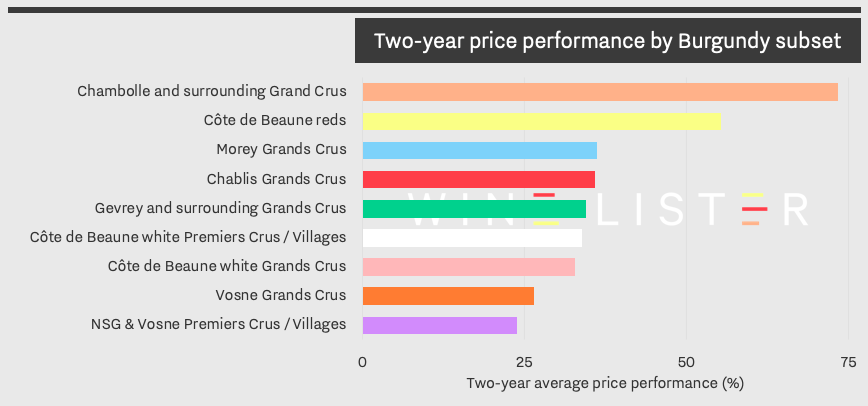 The two-year price performance of a basket of 175 Burgundy wines (the same wines featured in our previous study on the region in 2018), based on the last 30 vintages. Price data partner: Wine Owners.
The two-year price performance of a basket of 175 Burgundy wines (the same wines featured in our previous study on the region in 2018), based on the last 30 vintages. Price data partner: Wine Owners.
As shown in the chart above, Chambolle and its surrounding sites lead in the price performance of Burgundy Grand Crus, followed by wines hailing from its northerly neighbour, Morey-Saint-Denis. The notorious sub-set of Grand Crus from around Vosne – home of legendary Richebourg, La Tâche, Echezeaux, and Romanée-Conti – has seen slower price performance, which is matched with lower popularity growth (see below).
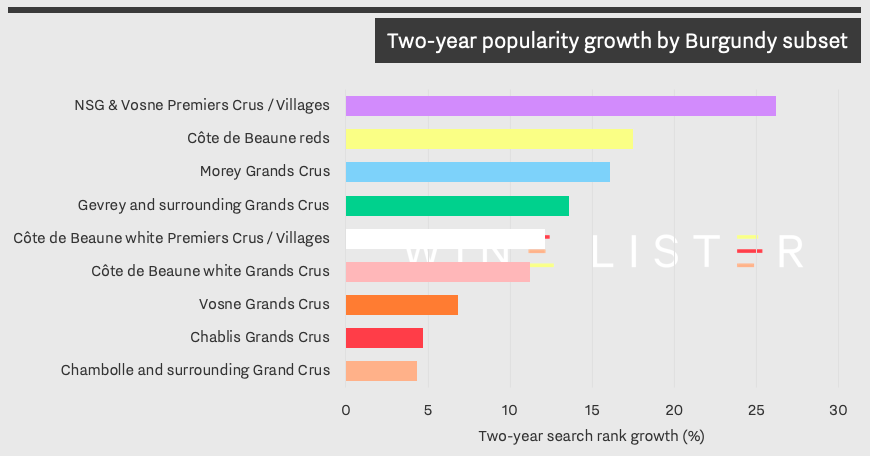 The two-year popularity growth of each Burgundy subset. Popularity data partner: Wine-Searcher.
The two-year popularity growth of each Burgundy subset. Popularity data partner: Wine-Searcher.
Though Chambolle and its surrounding Grand Crus have excelled in two-year price growth, consumer interest in the wines of this subset increased the least. Following similarly this opposing relationship between the two data sets, Nuits-Saint-Georges / Vosne Premiers Crus and Village wines gained the most popularity over the last two years by a large margin, while the subset’s price performance trails behind in last place.
A growing interest in lower-priced wines from Burgundy is further explored through trends identified by key members of the international fine wine trade in Wine Lister’s report. Producers such as Arnoux-Lachaux and Georges Mugneret-Gibourg are well worth looking out for when buying Burgundy en primeur for drinking in several years’ time.
Visit the Analysis page to purchase Wine Lister’s in-depth 2020 Burgundy study, or download it using your Pro subscription here (available in both English and French).
Burgundy prices continue to rise, and top wines are becoming ever-harder to access – but must what goes up really come down?
Wine Lister has published its second in-depth Burgundy report, with contribution from partner critic and leading Burgundy expert, Jasper Morris. With insights from key fine wine trade players from across the globe, the report investigates the state of Burgundy compared to other major fine wine regions, and discusses projections for its future performance.
Please see our key findings below:
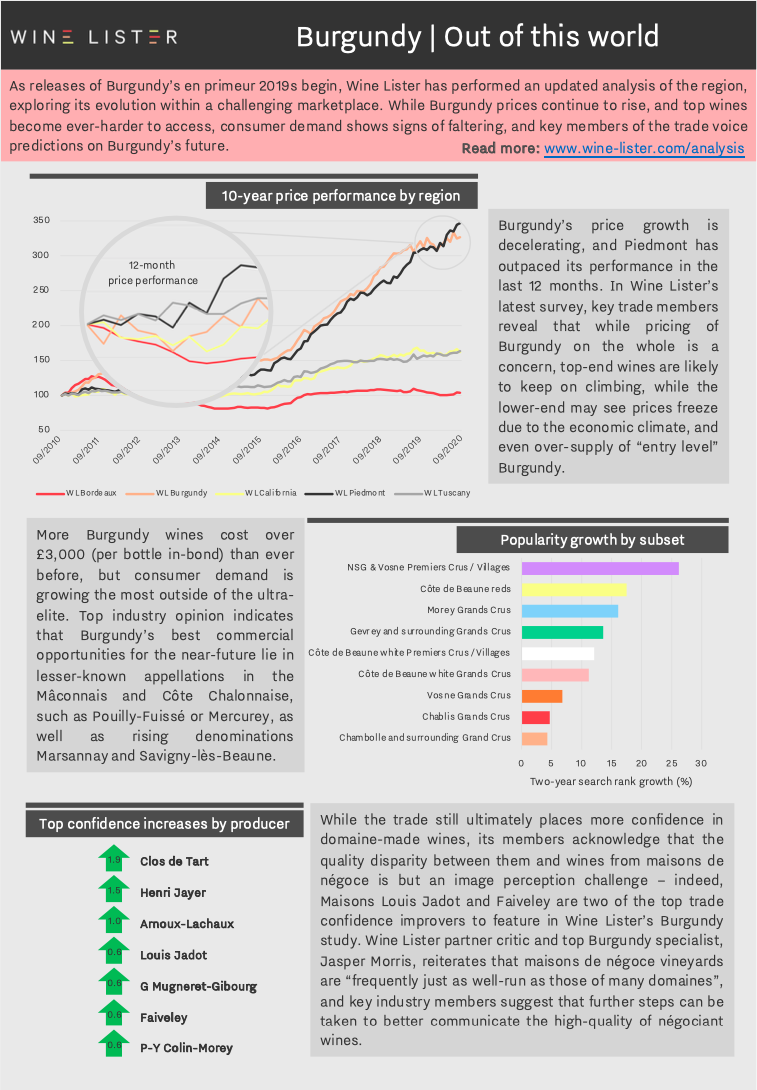
You can download the study digest in English here: Wine Lister Burgundy Study Digest 2020 or French here: Wine Lister Étude Bourgogne 2020 – Résultats Clés. The full report can be purchased on our Analysis page, while Pro subscribers can access their free copy here.
As much of Europe re-enters lockdown, the fine wine industry is once again adapting through the digital world. With many reliable retailers now running e-commerce platforms, there is simply no excuse not to purchase top-quality wine from the comfort of your own home. To help you get the best from your online buys, Wine Lister offers its top tips on avoiding compromise on your acquisitions, whether for drinking or for laying down in the cellar.
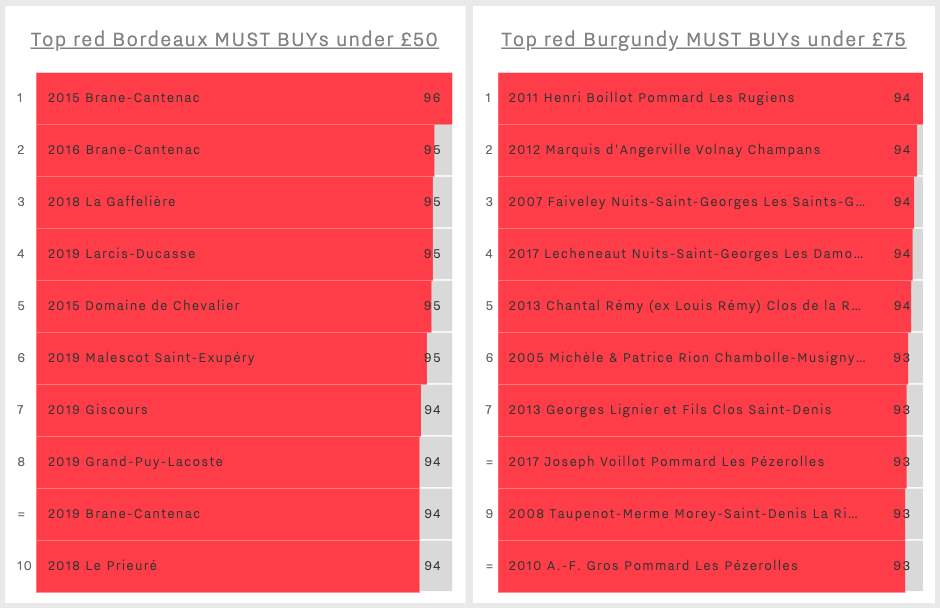
- Narrow down your drinking delights
With a plethora of brilliant bottles now available to purchase online, Wine Lister’s free tools provide a good place to start your decision journey, helping you to refine your browsing before you even begin. On top of our MUST BUY recommendation algorithm, our Wine Leagues provide top-10 lists of the best wines to source for given categories, be it appellation, price, or WL score (a quality measure comprising ratings from Wine Lister’s partner critics). Featured on the individual wine pages, Wine Lister’s drinking windows inform you of the best time to open your bottle, another key factor to consider when buying wine. The above sets of Wine Leagues reveal the top Bordeaux reds for under £50 (per bottle in-bond) and the top Burgundy reds for under £75.
- Elect an esteemed merchant
Whether you have determined what you want or not, it is crucial to buy only from trusted merchants. While pricing may vary, Wine Lister recommends sticking with reputable retailers to ensure top-notch provenance and delivery. The list of legitimate options is long, but we suggest the following (to name but a few): Berry Bros & Rudd, BI Fine Wines, Corney & Barrow, Goedhuis & Co, Justerini & Brooks, Lay & Wheeler, and Vinum Fine Wines.
- Refine through regional specialists
If your focus is on one region in particular, it can be beneficial to buy from specialist merchants. For example, Stannary Wines represent several top Burgundy producers, and Armit Wines are the agent for a number of leading Italian estates, providing dependable platforms for you to direct your search. It is useful to know which merchants are the primary UK importers of specific domains, for example, Justerini & Brooks represent Philipponnat Clos des Goisses, and Four Corners work with many top Californian fine wines.
For more industry insights and advice on which wines and regions to buy, sign up for Wine Lister’s free newsletter here.
Over the past decade, biodynamic wine has exploded in popularity, particularly amongst a younger generation of wine drinkers. Having spoken to a selection of top producers that follow biodynamic farming, Wine Lister’s latest investigation attempts to explore the practice further, and better understand the shared values of this often-misunderstood philosophy.
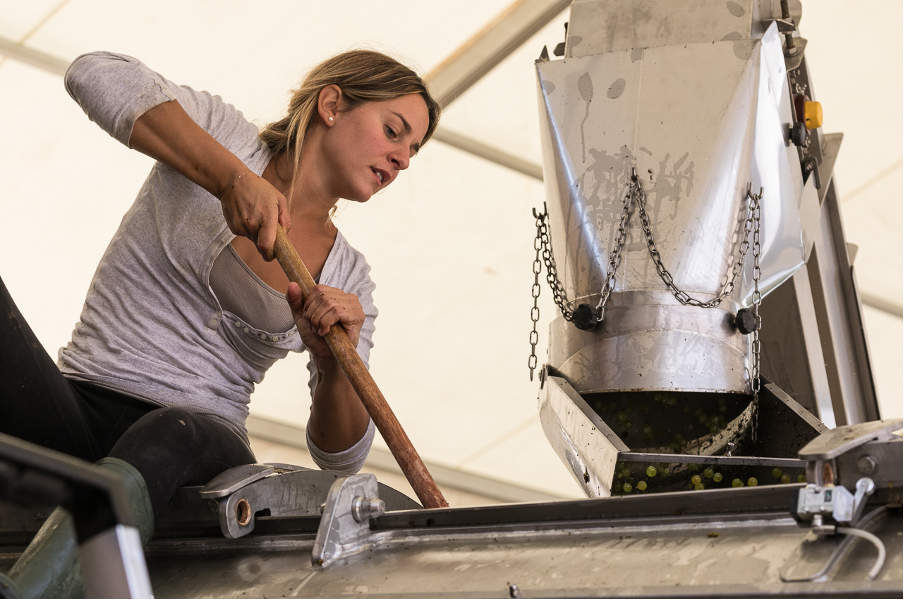 The biodynamic calendar: racking at Comtes Lafon (pictured) is timed according to the lunar phases (Photo: Jean Chevaldonné)
The biodynamic calendar: racking at Comtes Lafon (pictured) is timed according to the lunar phases (Photo: Jean Chevaldonné)
Often associated with organic winemaking, biodynamics also dictates the avoidance of pesticides and chemical fertiliser, and many of its wines are therefore organic in practice. Certified by independent associations (e.g. Demeter and Biodyvin) rather than the government, biodynamics goes one step further, providing a more holistic approach to farming that attempts to embrace all natural biological processes. Coined in 1924 by Rudolf Steiner – an Austrian philosopher and scientist – biodynamics draws on the specific belief that all living species experience constant transformation, due to physical, metaphysical, and cosmic realities acting upon them. While it is not essential for certification, most biodynamic producers therefore follow the biodynamic lunar calendar, which dictates the optimum days for viticulture and winemaking activities, based on the moon’s cycle.
In Burgundy, Comtes Lafon plans its planting, pruning, harvest, racking, and bottling according to the lunar calendar (see photo above), despite not being certified officially. Having shifted to biodynamic farming in 1998, owner and winemaker, Dominique Lafon, tells us that he was initially inspired by the practice in several of his friends’ vineyards at the time, and was “impressed by the way the vines behaved”. He states that while it is more time consuming, biodynamic farming provides him “pleasure to work closer to the vineyards, following their natural rhythms”.
Among a list of other principles, biodynamic producers must complete a cow horn preparation, otherwise known as process 500, in which manure is packed into the horn of a female cow and buried under the vines for six months. The horns are then dug up, and the content of the horns is combined with water and sprayed across the vineyards, in the belief that the solution enhances plant growth and improves the quality of the crops. Dominique tells us that while some results of biodynamic farming can be seen “rapidly, within the first year”, process 500 begins to change the soil “after three years or so, and is fully effective after 10 years”.
In Bordeaux, Château Palmer also completes the cow horn preparation (pictured below) – the Margaux estate began experimenting with biodynamics in 2008, adopting it completely in October 2013, and releasing its first certified vintage in 2018. Winemaker Thomas Duroux, tells us that the adoption of such biodynamic principles has yielded “results in the vineyard” and encouraged “better quality soil”, while helping him to achieve his goal of “growing a vineyard without any use of chemicals”. Explaining the difference between organic and biodynamics, Duroux notes that the latter is “a different way to see agriculture”, and that when you apply biodynamic principles, “you see the farm as an ensemble”. This resonated across several other biodynamic producers, who similarly considered biodiversity to be at the core of this mode of farming.
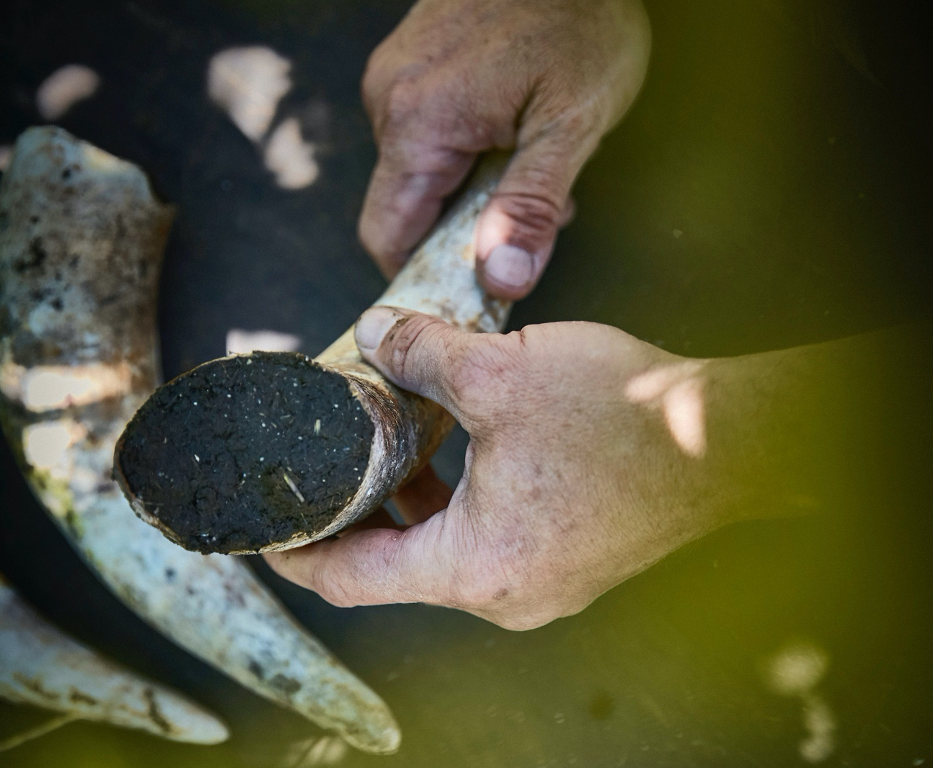 Process 500: biodynamic compost preparations at Château Palmer
Process 500: biodynamic compost preparations at Château Palmer
Indeed, Elisabetta Foradori tells us that since its conversion, Foradori has founded a new focus on biodiversity and sustainability, with livestock now used to produce dairy products and compost for the vineyard. She began to introduce biodynamic principals into the family estate in 1999, converting the whole property in 2002, and eventually achieving certification in 2009. Foradori tells us that she had begun to feel “disconnected to the plants after many years of working in wine”, and biodynamic viticulture allows her to “go into the deepness of the life of the plant and its soil”. She states that the practice has catalysed an “evolution in the fertility of the soil”, watching vine roots “grow deeper and deeper”.
Further south in Chianti, Querciabella conversely practices a “cruelty-free” biodynamics, according to its team, without the use of manure or animal remnants in the soil. Winemaker Manfred Ing states that while “eliminating all of the animal-based preparations”, the estate has implemented a strict cover crop preparation, planting up to 35 different plants across its vineyards, depending on the soils and the grapes that grow in each plot. He states that this improves the quality of the land, whilst adhering to the biodynamic principle of “getting as much quantifiable life in the soil and the vineyard as possible.”
Following the general sentiment of other biodynamic producers, Elisabetta Foradori states biodynamic farming enables the wine to “reflect the message of the terroir” while encouraging “purity and character”. This was particularly pertinent to one of Burgundy’s biodynamic pioneers, Leroy – speaking to Wine Lister, the team notes that biodynamic farming indeed helps the property to better “express the character” of its respective sites. Having implemented biodynamic farming since the day it was purchased by Lalou Bize-Leroy in 1988, the team tells us that “no one else was even organic” in the region at that time, and people “thought it was crazy” to neglect the use of fertiliser and risk decreased yields. They explain that Burgundy is an “ideal place” for biodynamic farming, through its ability to express the disparities between the different vineyard holdings of the same Burgundy varietal – a “true test of where the wine comes from”.
While biodynamic producers approach the practice with variable interpretations, its practitioners are nonetheless enthusiastic about its results. With an increasing number of producers adopting this mode of farming, we look forward to witnessing its wider recognition across the fine wine industry in years to come.
Wine Lister’s latest MUST BUY update identified 38 new wines that show quality and value within their respective vintages and appellations, and wide praise from the international trade. To help you discover these new picks, this week’s blog takes a deep dive into the latest MUST BUY wines and their geographical composition.
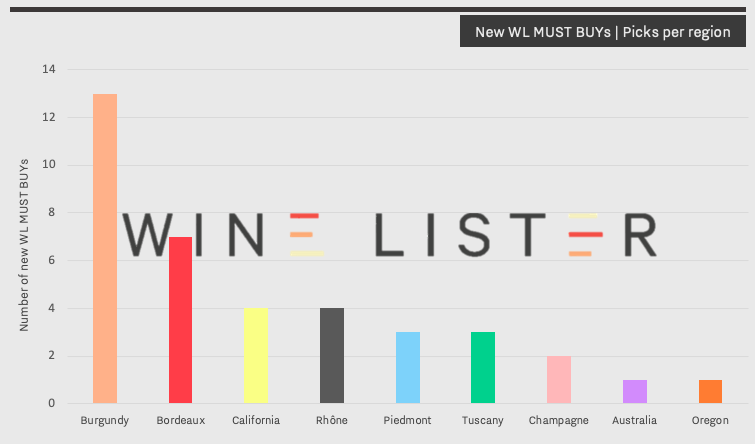
Pinot Noir picks
Burgundy dominates the new MUST BUY hoard with 13 entries, including eight reds. The perfect pick for an opulent occasion, the 1978 Romanée-Conti Richebourg costs £1,434 per bottle (in-bond), and was described by Wine Lister partner critic, Jancis Robinson, as “very long with smoothness, sweetness and unctuousness”. Sharing its WL score of 96, the 2010 Volnay Clos des Ducs from the Côte de Beaune’s red producer of reference, Marquis d’Angerville, provides a more affordable option at £250 per bottle (in-bond), but may merit a little patience.
Outside of Pinot Noir’s original homeland are some new MUST BUYs of brilliant quality and impressive value for money. California’s 2016 Au Bon Climat Isabelle Pinot Noir has a WL score of 94, and was described by Wine Lister partner critic, Antonio Galloni, as “racy, perfumed and beautifully layered”, with notes of “orange peel, tobacco, blood orange, spice, star anise and new oak” throughout. It can be purchased for less than five times the price of the aforementioned Volnay, by the case of six for £262 (in-bond) from Jeroboams.
Travelling north within the US brings us to Oregon’s latest MUST BUY entry – the 2016 Cristom Louise Vineyard Pinot Noir. While more expensive than its Californian counterpart for the same WL score, Cristom’s position as the leading producer in the Willamette Valley, alongside its closer proximity to Burgundy’s cool-climate restrained style, makes it more than worth the c.35% premium. It is available to purchase for c.£60 per bottle (in-bond) from WineBuyers.com.
The best of Bordeaux blends
Bordeaux offers seven new MUST BUYs this week, including two Left Bank Value picks; 2019 Haut-Bages Libéral and 2015 Capbern. With a WL score of 92, the former addition was released en primeur two months ago, and described by James Lawther for JancisRobinson.com as, “busy and expressive on the nose with vineyard-fresh dark fruit, black-olive and mineral notes”. Labelled by Lawther as the “best in recent years”, this gem from Bordeaux’s prominent promotors of biodynamic viticulture, Gonzague and Claire Lurton, has a bright future ahead. It can still be bought en primeur through Justerini & Brooks for £142.50 per six (in-bond).
The 2010 Vieux Château Certan also appears in the latest MUST BUY update, 10 years on from the iconic vintage. It provides a more lavish option for the Bordeaux buyer, receiving a WL score of 96 at £216 per bottle (in-bond). Moving across the border into Tuscany, the 2010 Sassicaia also offers a more luxurious alternative to the Bordeaux blend. Comprising of 85% Cabernet Sauvignon and 15% Cabernet Franc, it was described by Antonio Galloni as, “just beginning to show the first signs of aromatic development”, including hints of “sweet tobacco, mint, pine, dried cherries and licorice”. It achieves a WL score of 95, and is available to purchase by the case of six for £915 from Goedhuis & Co.
Choosing Chardonnay
Back to Burgundy, and the new white MUST BUYs this week offer opulence from three iconic Meursault producers; 2015 Roulot Charmes, 2010 Comtes Lafon Genevrières, and 2017 Arnaud Ente Les Petits Charrons are all exceptional choices, albeit for an average price of £492 per bottle (in-bond). Further north, two entries hail from Chablis, and the appellation’s original historic vineyard, Les Clos; 2014 Laroche Les Clos, and 2010 Christian Moreau Père et Fils Les Clos. For those who enjoy a more pure, lean, and mineral style of white wine, the Chablis MUST BUYs exhibit notable value within their appellation and achieve higher WL scores than their buttery Meursault counterparts. The latter can be bought by the case of 12 from Cru World Wine for £871 (in-bond).
California’s latest white MUST BUY hails from Kistler Vineyard; a cult producer known for its emulation of pure and balanced Burgundian Chardonnays, over the rich and oaky Californian style. The 2017 Kistler Vineyards Dutton Ranch Chardonnay achieves a WL score of 96, and is labelled by Antonio Galloni as “such an intriguing wine because of the way it is airy and lifted and yet also so deep in feel”. Providing a less expensive alternative to Côte d’Or whites, it is priced at £133 per bottle (in-bond).
Also featured in the list of new MUST BUYs are: 2009 Abreu Madrona Ranch Cabernet Sauvignon, 1989 Bollinger Grande Année, 1996 Bruno Clair Chambertin Clos de Bèze, 2006 Cavallotto Barolo Vignolo Riserva, 2013 Ceretto Barolo Brunate, 2012 Conti Costanti Brunello di Montalcino Riserva, 1996 Dunn Vineyards Howell Mountain Cabernet Sauvignon, 2014 Duroché Chambertin Clos de Bèze, 2017 Georges Mugneret-Gibourg Clos de Vougeot, 2012 Jacques-Frédéric Mugnier Chambolle-Musigny Les Amoureuses, 2014 Jean Grivot Richebourg, 2010 Jim Barry The Armagh Shiraz, 2017 Joseph Drouhin Chambolle-Musigny Les Amoureuses, 1996 Lafite Rothschild, 2008 Lafleur, 2016 Le Macchiole Paleo Rosso, 2016 l’Evangile, 2006 Louis Roederer Cristal Rosé, 2018 Marc Sorrel Hermitage, 2013 M. Chapoutier Hermitage Ermitage Blanc De l’Orée, 2016 M. Chapoutier Hermitage Ermitage Le Méal, 2012 Roagna Barbaresco Pajè Vecchie Viti, 2016 Valandraud, and 2009 Vincent Paris Cornas La Geynale.
With so many interesting offers coming in from different merchants, it can be tricky to keep track of what wine you have, let alone where it is, and when it should be drunk. To help you get the most out of your wine collection, Wine Lister has opened up its data analysis and fine wine expertise to private clients, who can now commission all kinds of portfolio analysis, from detailed geographical split and purchase advice, to investment forecasting and a fully-fledged “drink vs. sell” plan.
Wine Lister’s “fantasy cellar”
The current list of Wine Lister MUST BUYs – wines showing notable quality and value within their respective vintages and appellations, and wide praise from the international trade – is 1,728 picks strong. While the Wine Lister team would love to own (and enjoy) all of them, below is a short selection to be put away and enjoyed at their best in five, ten, and twenty years, respectively.
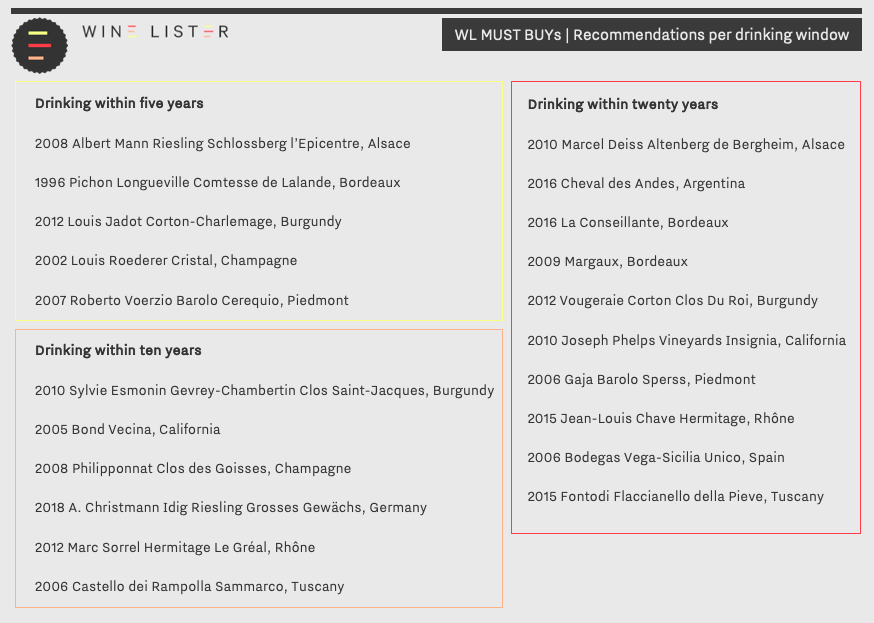
Riesling to reserve
With remarkable ageing potential, and good value across the board, Riesling constitutes a brilliant white addition to any wine collection. To be opened within ten years, the 2018 A. Christmann Idig Riesling Grosses Gewächs hails from Germany’s famed Mosel, and is described by Wine Lister partner critic, Jancis Robinson as “the thinking-person’s Riesling”. She notes the “understatement of individual components” in the wine, “which allows the taster to focus on balance and elegance”. Creeping over the border into the Alsace, where Riesling tends to be drier in style, Albert Mann’s 2008 Schlossberg l’Epicentre is ready but will improve – offering optimum enjoyment within the next five years. Another Alsatian, the 2010 Marcel Deiss Altenberg de Bergheim can endure another 20 years of ageing, also providing a reliable white to add to any cellar. Wine Lister partner critic, Antonio Galloni, describes its “perfumed aromas of nectarine, apple blossom, minerals and honey”, calling it “vibrant and penetrating”. With notable value for their quality, the three Rieslings achieve a shared WL score of 96, at £54, £98, and £59 per bottle (in bond), respectively. For something to stash away, the latter is available by the case of six from Millésima UK.
Burgundy on standby
Louis Jadot Corton Charlemagne 2012 is a similarly reliable white to be stored in the cellar, achieving a WL score of 95 at £126 per bottle (in-bond). Barrel-fermented and aged for a further eight to ten months in 100% new oak barrels, the wine has developed complexity and enhanced ageing potential. Production in 2012 was kept notably small – indeed winemaker Frédéric Barnier states, “it is critical to control the yields in Corton-Charlemagne to make a wine of real Grand Cru quality.” It can be purchased by the case of 12 from Fine+Rare Wines, and can be opened within five years. Burgundy also offers an abundance of reds with promising ageing potential, including the 2010 Sylvie Esmonin Gevrey-Chambertin Clos Saint-Jacques, and the 2012 Vougeraie Corton Clos Du Roi. Both wines achieve a WL score of 95, at £192 and £90 per bottle (in-bond), respectively.
Champagne to store
A sure pick to pop open within five years, the 2002 Louis Roederer Cristal was aged on lees for six years, before being matured for a further eight years in bottle after its disgorgement in 2009. Wine Lister partner critic, Jeannie Cho Lee notes that it is a “gorgeous Cristal with a fine line of acidity running through it – it vibrates on the palate”. With a WL score of 96, at £192 per bottle (in-bond), it is available in cases of three from Vinum Fine Wines. With an identical WL score of 96, the 2008 Philipponnat Clos des Goisses can be acquired by the case of six for £850 (in bond) from Justerini & Brooks, to be enjoyed within the next decade.
New World to wait for
For some New World picks that are worth putting away for the future, Napa Valley offerings include the 2005 Bond Vecina (owned by the famed Harlan family) and the 2010 Joseph Phelps Vineyards Insignia. In regards to the former, Antonio Galloni stated that he would “prefer to cellar it, as the future for this wine is unquestionably very, very bright”. With a WL score of 97, at £347 per bottle (in-bond) it is an opulent option to be enjoyed within the next twenty years. Of the 2010 Joseph Phelps Vineyards Insignia, Galloni states similarly that “the 2010 will enjoy a long drinking window once it softens”. Achieving a WL score of 96, at £158 per bottle (in-bond), it is available in cases of six from Goedhuis & Co.
Also featured in the above MUST BUY recommendations are: 2016 Cheval des Andes, 2016 La Conseillante, 2015 Fontodi Flaccianello della Pieve, 2015 Jean-Louis Chave Hermitage, 2012 Marc Sorrel Hermitage Le Gréal, 2009 Margaux, 2007 Roberto Voerzio Barolo Cerequio, 2006 Bodegas Vega-Sicilia Unico, 2006 Castello dei Rampolla Sammarco, 2006 Gaja Barolo Sperss, and 1996 Pichon Longueville Comtesse de Lalande.
For personalised, impartial fine wine purchase recommendations, as well as further wine collection analysis, get in touch with our team at team@wine-lister.com, or download the full Cellar Analysis information pack.
Part I of Wine Lister’s annual in-depth Bordeaux report: For better, for worse, examines the state of the market for Bordeaux wines, in the context of 2019 en primeur.
As well as providing insight into the wine trade’s latest position on key wines of the region, the study examines Bordeaux’s disconnect between consumer popularity and its market performance at the start of 2020 (exacerbated by recent macro-economic hits to the UK, Hong Kong, and the US).
As illustrated below, Bordeaux has achieved the slowest price growth on the secondary market since May 2014, while Piedmont has seen the most impressive growth – likely due to increasing attention given to the region, and the rarity factor of many of its top wines, from which Burgundy also benefits.
 The price performance of Bordeaux compared to four other key fine wine regions: Burgundy, California, Piedmont, and Tuscany. The price indices comprise the top five wine brands in each respective region.
The price performance of Bordeaux compared to four other key fine wine regions: Burgundy, California, Piedmont, and Tuscany. The price indices comprise the top five wine brands in each respective region.
A glance at its price performance since May 2019 tells a similar, if more unnerving story – Bordeaux has floundered over the past year, down nearly 5%.
Despite its price performance difficulties, Bordeaux nonetheless continues its legacy as the most popular wine region by a large margin, based on monthly searches made on Wine-Searcher.
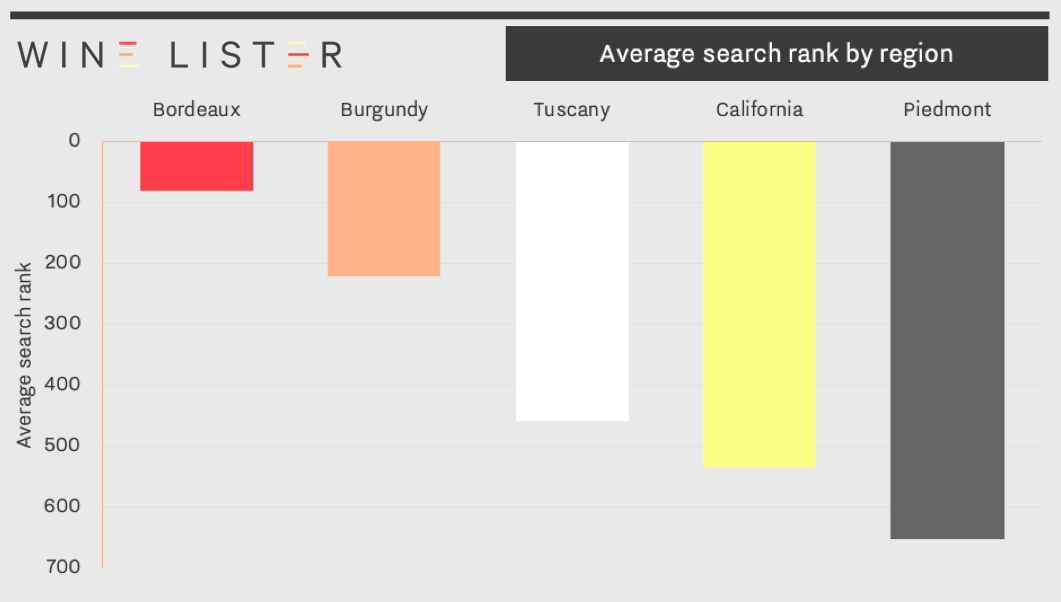 The average search rank of Bordeaux compared to four other key fine wine regions: Burgundy, California, Piedmont, and Tuscany. Results are based on the average searches on Wine-Searcher for the 50 top-scoring wines per region over the last year.
The average search rank of Bordeaux compared to four other key fine wine regions: Burgundy, California, Piedmont, and Tuscany. Results are based on the average searches on Wine-Searcher for the 50 top-scoring wines per region over the last year.
Irrespective of its price performance struggles, Bordeaux remains a focus of fine wine buyers – within the trade and beyond – all over the world. The en primeur campaign is a wheel that just keeps on turning, even in spite of a global pandemic. Trade and consumers alike can’t help but back Bordeaux, for richer and poorer.
More insight into the success of the 2019 en primeur campaign will be included in Part II of this study. In the meantime, visit the Analysis page to purchase Part I, or download using your Pro subscription (available in both English and French).
 From left to right: Axel Heinz, Chiara Boschis, Gaia Gaja, Jacques Devauges, and Marielle Cazaux
From left to right: Axel Heinz, Chiara Boschis, Gaia Gaja, Jacques Devauges, and Marielle Cazaux  From left, Nicolas Audebert, Nicolas Glumineau, Pierre-Olivier Clouet, Veronique Boss Drouhin, and Will Harlan
From left, Nicolas Audebert, Nicolas Glumineau, Pierre-Olivier Clouet, Veronique Boss Drouhin, and Will Harlan





 The biodynamic calendar: racking at Comtes Lafon (pictured) is timed according to the lunar phases (Photo: Jean Chevaldonné)
The biodynamic calendar: racking at Comtes Lafon (pictured) is timed according to the lunar phases (Photo: Jean Chevaldonné) Process 500: biodynamic compost preparations at Château Palmer
Process 500: biodynamic compost preparations at Château Palmer


